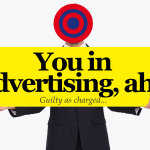Summer on the Mornington Peninsula. Patrick, 4, is visiting from France and sampling Aussie television. But every time an ad comes on, he runs from the room crying for his mother.
If I hadn’t seen this with my own eyes, I might not have believed it, but Patrick’s anathema is shared by the rest of us. We hate ads, we continually tell each other, disdainful of an $17.2 billion industry that keeps our media afloat.

Well be careful what you wish for, because the coronavirus crisis has plunged our media into a new crisis. Yes, audiences now flock to television, particularly news programmes, newspapers sell out in suburban supermarkets, online news site readership surges (particularly on desktops as we stay home). But this is not a crisis of audiences, this is a crisis of advertising. And we are just beginning to find out what that means.
ACCC chair Rod Sims calls it a “one-two blow” for media companies whose revenues have been decimated this past decade by digital giants Google and Facebook.
Last week News Corp Australia closed print editions of its 60 community titles, including the Mosman Daily and Northcote Leader. They had no cover price and were dependent on advertising from local businesses themselves on life support. This newspaper company suspended several supplements and magazines.
Seven West Media asked staff to take a 20 per cent pay cut. Network Ten is extending Easter holidays and asking staff to work part time.
Australian Community Media, home of the Bendigo Advertiser, Newcastle Herald and 160 print and digital titles, is still publishing, but COVID-19 has knocked executive chairman Anthony Catalano’s quest to remake the regional advertising market for six.
Smaller regional titles, including Gawler’s historic The Bunyip newspaper, published in South Australia since 1863 and Broken Hill’s Barrier Daily Truth, are suspended and might not be back.
Thanks to the coronavirus hibernation, major print publishers can expect a 50 per cent fall of ads in the next six months. The famed “rivers of gold” will be looking more like Menindee Lakes.
Ironically, this is happening at a time when self-isolating audiences are embracing mainstream media. Nearly two million people nationally are watching Seven News, other news services and special bulletins are experiencing huge surges.

Sky News is the number one channel on Foxtel. News Corp Australia told ad clients in a note last week total readership is up 81 per cent, while print and digital subscription sales are up 287 per cent, (287 per cent) not just because of the free offers. Executive chairman Michael Miller told clients that audiences had “exploded” and subscription increases were “the most dramatic we have ever seen”.
He went on to remind clients that much of the content was “plundered digitally by tech giants for their own profits without any commitment to local communities”.
The sad fact is, even if booming circulation and bumper ratings, without advertising the cost base of our newspapers and television networks becomes unsustainable.
Please don’t say, what about subscriptions? Despite 167 million global subscribers, Netflix burns cash, employs a handful of Australians and produces almost no local content.
Some expect print advertising revenue to plunge up to 50 per cent this year. Digital ad revenue is sliding too, despite increased online audiences. CPM, the unit of digital advertising which designates the amount an advertiser pays per one thousand eyeballs, is falling rapidly, down 20 per cent last year and 40 per sent this year. What once paid media companies $10, now pays just $6.
Businesses are adjusting to the new normal and some advertising briefs are starting to flow through.
Supermarkets and banks still very visible, with information and branding messages emphasising they are here to help. Government COVID-19 health ads are everywhere. And 170 new advertisers have started using commercial radio in the past fortnight, including video conferencing services and fast food outlets according to the RadioInfo website.
Communications minister Paul Fletcher is yet to reveal his response to this crisis.
The ACCC’s code of conduct to ensure digital giants pay creators of original journalism is still moving towards it progress report deadline in May and ultimate agreement in November. It won’t be enough and it won’t be soon enough.
Advertising can be part of our cultural fabric as well. Happy Little Vegemites or Not Happy Jan. Little Audrey, our first animated neon sign when installed in Richmond in Melbourne in 1936, is heritage listed and when poet Kenneth Slessor paid homage to 1930s Sydney nightlife, “red globe of light, the liquor green, the pulsing arrows and the running fire” he was talking about advertising billboards.
Audiences flocking to TV shows and news sites during the coronavirus hibernation should be just as alarmed about advertising’s demise as the industries that depend on it.
source: https://www.smh.com.au/
MARKETING Magazine is not responsible for the content of external sites.









